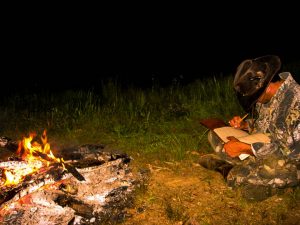In the shadows, silent creeks tilt clear water towards the Savannah and kingfishers peel down from the box elders to scatter shimmering schools of little bream. Moccasins as big around as pulp timber slip across in broad daylight and giant gar, toothy and archaic, roll idly in and out of the shadows. Along these drainages are the richest bottomlands shaded by mammoth oaks and sycamores, where turkeys roost and copperheads, embellished with the exquisite pastels of oak and sunlight, rest like a savage poem in the leaves.
Winding through Abbeville and McCormick counties, Long Cane Creek was so named for the dense colonies of river cane, canebrakes, which the first Europeans found along its rich floodplains. Steven’s creek forms the boundary between McCormick and Edgefield before emptying into the Savannah about thirty miles south of the Long Cane-Savannah-confluence. Of tall pines, sunbaked highways and dusty logging roads, this stretch of South Carolina’s western Piedmont is quite forgettable. But it was a hot bed of travel, settlement, commerce and war for centuries before the first European, with no shortage of land treaties, peace treaties and bloodshed following European settlement. The Long Cane region held the footprints of Desoto, Attacataculla, Calhoun and Bartram. This place saw the rise and fall of both the Cherokee Nation and of king cotton. Today it is a landscape of understated beauty where finely knapped arrowheads, musket balls and tilted headstones lie scattered, quietly forgotten beneath rank upon rank of tall pines.
Hernando Desoto was the first European to encounter the Long Canes when he and his troops forded Stevens Creek in present-day McCormick County in April of 1540, just a few miles southwest of the present-day town of Modoc. It would be almost two centuries before Europeans would again pass through the Long Canes. By the late 17th Century, the Lower Towns of the Cherokee in present-day Keowee, Seneca, Toxaway and Jocassee, controlled and fiercely defended the Long Canes; though it seems they permitted, or otherwise tolerated, the Creek and Choctaw to travel through. The Cherokee’s most profound signature on the face of the land was written in the form of fire. Almost yearly they would set the landscape ablaze to flush game or clear land for agriculture. Fire, along with grazing by large herbivores like bison, maintained the piedmont oak-hickory savanna for centuries. In The Making of McCormick County, Bobby Edmonds describes the pre-colonial Long Cane Region:
“The whole countryside was an adorned savanna as far as the eye could see – carpeted with wildflowers of every hue, canes, wild-pea, and native grasses in profusion, and trees spaced so far apart that deer and buffalo could be seen from afar …. Buffalo, deer and black bear abounded. The shaggy buffalo would later lend its name to locals like Buffalo Creek, Little Buffalo Creek, and Buffalo Baptist Church [still holding services]. A hunter from Ninety-Six reported counting more than a hundred buffalo grazing on a single acre near Long Cane Creek.”
William Bartram, known by the Cherokee as Puc-Puggy, signifying “Flower Hunter”, passed through the Long Canes in 1773. The following entry from Bartram’s Travels is worth additional consideration:
“Turkeys, quails and small birds, are here to be seen; but birds are not numerous in [uninhabited] forests; they draw near to the habitations of men, as I have constantly observed in all my travels.”
Why might turkey, quail and small birds constantly “draw near to the habitations of men”? The habitations to which Bartram was referring were both the inhabited and abandoned Native American villages. The disturbance created by their agriculture, and to a greater extent fire, suppressed tree regeneration and encouraged early-successional flora; consequently, a diverse community of grasses and forbs thrived in the abundant sunlight beneath a sparse overstory along the Piedmont uplands. This explains the account “…trees spaced so far apart that deer and buffalo could be seen from afar.” Thus, the Piedmont prairie extended north into eastern Virginia and west to the Appalachian foothills, and certainly well inland of the longleaf pine-wiregrass range.
Those Piedmont prairies were excellent grazing for livestock as well as wildlife, and hunters, traders and cattlemen began filtering into the South Carolina backcountry. In 1715 John Stevens set up cow pens along a Cherokee path which crossed a creek that would later bare his name, and the Stevens Creek Settlement would stretch along the Savannah between Stevens Creek and Turkey Creek; likewise, cow pens along Little River, Turkey Creek, Cuffeytown Creek and Hard Labor Creek were established. Foremost in number among these early settlers were Scotts-Irish families from the Shenandoah Valley. They brought with them a Protestant heritage, a deeply engrained conviction for autonomy and an identity bound to the land, and they were quick to fight for all three. The Pickens, Jacksons and Calhouns were among them. The Calhouns settled briefly on Long Cane Creek before they relocated a short distance to a site along Little River near present-day Mt. Carmel in McCormick County in 1756. The site they chose was on Cherokee lands, a brash decision that would prove fatal just a few years later. But relations were more-or-less stable at the time, as both people found the burgeoning market for deer hides to their advantage.
In October of 1759 a delegation of Cherokee chiefs and elders rode from the Keowee village in present day Oconee County to Charleston to resolve local frustrations. Instead of hearing their griefs, newly appointed South Carolina Royal Governor William Lyttelton detained twenty-eight of their leaders and marched them to Fort Prince George (now at the bottom of lake Keowee). Lyttleton demanded that chief Attakullakulla turn over warriors responsible for recent attacks against Carolina settlers in exchange for the detainees. Outraged, the Cherokee refused the exchange. In retaliation, Cherokee war parties moved swiftly southward toward the Long Canes.
However, a young Cherokee woman named Cateechee rode ahead of the war party to warn the settlers at Fort Ninety-Six, a few miles southwest of present-day Greenwood. Upon Cateechee’s arrival, word was immediately dispatched to the Calhoun settlement. Early the next day the war party descended on the Calhoun settlement only to find it deserted; however, they noticed fresh wagon tracks bearing southward and fell in behind the fleeing settlers. The war party caught up with them at Long Cane Creek and in short order killed fifty-six and took additional captives. Fifteen-year-old Rebecca Calhoun managed to escape the carnage by hiding in a canebrake. She would later become the wife of Andrew Pickens and the mother and grandmother of two South Carolina governors. The fight would be known as the Long Cane Massacre, and the war party would go on to attack Fort Ninety-Six and the Stevens Creek Settlement. The settlers killed in the Long Cane Massacre were buried in a mass grave days after the attack. Following a bloody campaign against the Cherokee, a treaty was settled in December of 1761, whereby the exchange of prisoners was agreed to and trade with the Cherokee was resumed. Later conflict in the Carolina Piedmont would lead to a second campaign against the Cherokee, ending in with the treaty at DeWitts Corner (present day Honea Path in Abbeville County) in 1777, wherein the Cherokee ceded their remaining lands in the Carolina Piedmont, including the fertile Long Canes. Nearly all the Cherokee towns and paths in South Carolina now lay beneath a chain of reservoirs along the Savannah River watershed from Clarks Hill to Lake Jocassee. But you can visit the site of the Long Cane Massacre and see the grave markers near the town of Troy in McCormick County.
By 1930, the gully washed Carolina Piedmont was among most severely eroded landscapes in the nation and, by that time, fire had been suppressed for a century. Without fire to control forest density, dense stands of timber sprung up over abandoned cotton fields as native Piedmont prairie flora withered away beneath the shade. The Long Cane Forest District was incorporated into the Sumter National Forest in 1936 as part of a federal initiative to restore marginalized and delinquent farms during the Great Depression. The Civilian Conservation Corps (CCC) went to work establishing roads, fire towers and began soil stabilization projects. The first loblolly pine seedlings were introduced to the Long Cane uplands in 1937, loblolly pine being the only merchantable product the depleted soils could sustain. Perhaps ironically, the timber market may have helped keep Piedmont prairie flora from fading away all together. By reopening the forest canopy and resetting plant succession, clearcuts represent a sort of stand-in for fire and thus a toehold for the native piedmont prairie flora, at least for the first few years after harvest.
Today, the Long Cane Ranger District spans 120,000 acres, covering parts of Abbeville, Edgefield, Greenwood, McCormick and Saluda counties. It is managed by the U.S. Forest Service and open to public recreation. While established trails are few, the landscape is accessible through a network of logging roads.
The high bluffs along Stevens and Turkey creek rise sharply above impressive mesic forest communities, known nationally for spectacular wildflower diversity, including several rare species. The largest known southern sugar maple in the state grows here, as well as a few remnant canebrakes. One can imagine that these bottomlands look today much as they did centuries ago. A canoe trail along Stevens Creek (check water levels first) is a great way to experience the remote bottomlands.
Restoration is still underway on the Long Cane uplands. Through timber thinning and prescribed fire, native Piedmont-savanna flora is recolonizing the forest floor on restoration sites. Liberated by sunlight and nurtured by fire, a century-old seed bank of native grasses, partridge pea, black-eyed-Susan, coneflowers, asters and a suite of other forbs and wildflowers find new life in the sunlight sifting through a sparse canopy. The response of ground-nesting birds and other wildlife is positive and unmistakable. Bobwhite quail, a shrubland obligate, are the charismatic keystone species of grassland habitats and it is largely under the banner of the bobwhite that much native upland habitat restoration is energized across the southeast. While the war cry of the Cherokee, Catawba, Choctaw will never again echo through the Long Canes, perhaps a different war cry, that of the bobwhite, may signal a new battle to restore a native landscape.
Private landowners interested in restoring native habitat are encouraged to reach out to their nearest Farm Bill Wildlife Biologist. Farm Bill biologists work out of local USDA offices throughout the state, offering landowners free assistance in designing, implementing, and funding habitat improvement on private lands.



